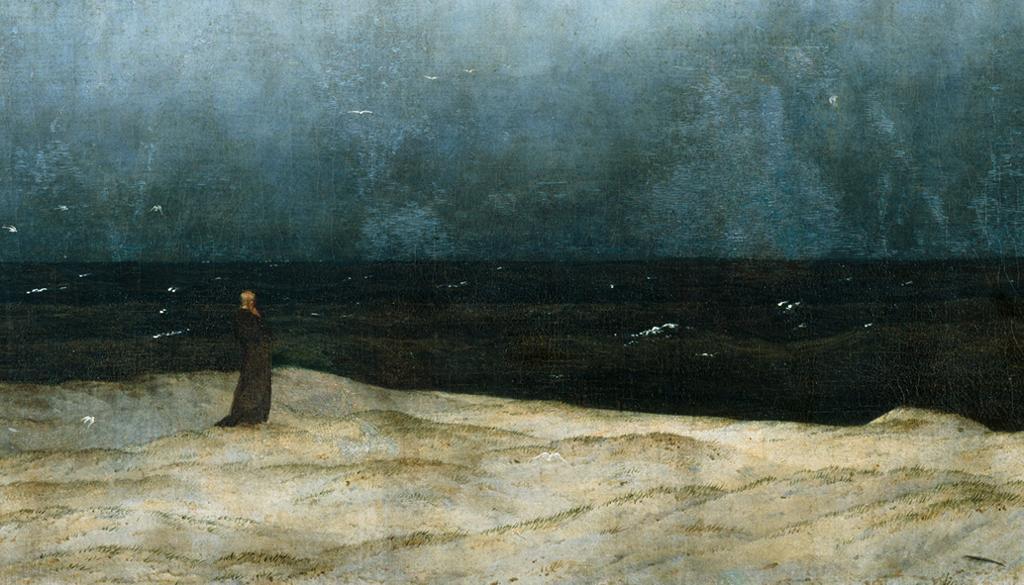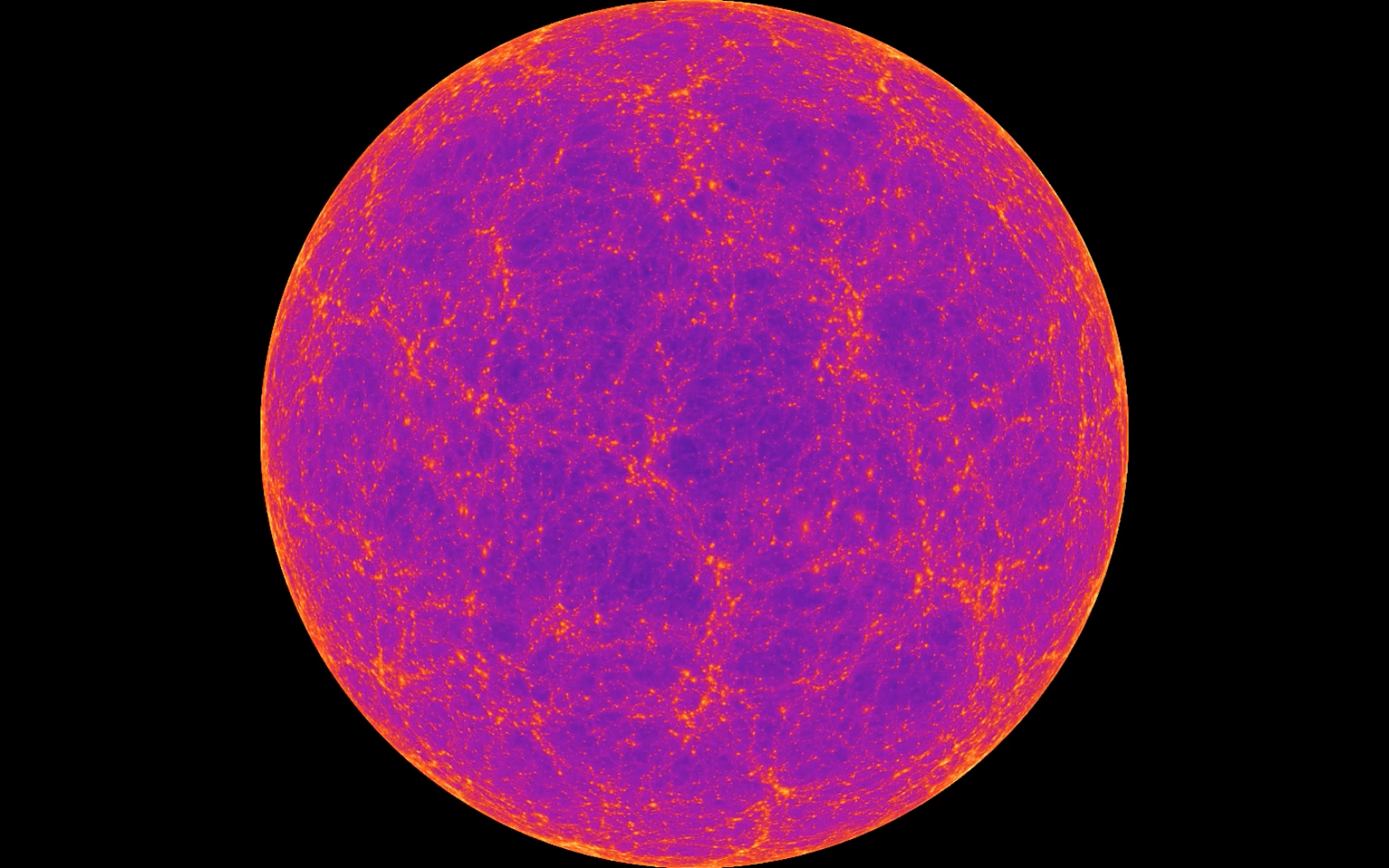Visualizing Dark Matter: Jim Cogswell reflects on his recent collaboration
In recent years my creative work has been influenced by astronomy, physics, archaeology, and other fields of scientific inquiry. This influence is founded on a much deeper and more lasting curiosity about how we as human beings know what we know, and how what we don’t know so neatly escapes us.
Two and a half years ago, I was invited by a cosmologist here at the University to participate in an unusual project. Greg Tarle, a professor of physics, does research on dark matter – the invisible stuff that scientists say makes up 24 percent of the universe.
Greg understands dark matter through the language of mathematics. For him, numbers and equations reveal a cosmological story so awe-inspiring that he was overtaken with a desire to share his wonder with others. He invited me to join a team that included musician/composer Stephen Rush to find a way, through art, to communicate the grandeur that he feels as he studies this great unseen mystery of the universe. This project became Jeweled Net of the Vast Invisible.
The challenge of visualizing the immense complexity of nature is not new to artists. Early in our project I introduced my scientific colleagues to the 19th century Romantic painters of Europe who had made similar attempts to address natures’ ecstatic beauty. And, I suggested he read Robert Rosenblum’s Modern Painting and the Northern Romantic Tradition.
Here is Caspar David Friedrich’s Monk by the Sea from 1809.

Rosenblum describes the work this way:
“Friedrich’s painting corresponds to an experience familiar to the spectator in the modern world, an experience in which the individual is pitted against, or confronted by the overwhelming, incomprehensible immensity of the universe, as if the mysteries of religion had left the rituals of church and synagogue and had been relocated in the natural world. It has almost the quality of a personal confession, in which the artist, projected into the lonely monk, explores his own relationship to the great unknowables, conveyed through the dwarfing infinities of nature.”
Rosenblum goes on to identify qualities of these paintings that correspond closely to those found in our project. Here are a few:
- Their images are of such elemental clarity and power that they can in no way be confused with a prosaic record of the casually observed data of nature.
- Their settings locate us near a precipice of nothingness.
- They communicate a mood of intense communion with the most impalpable of nature’s phenomena—light, color, atmosphere.
Visualizing the Unseen
The story of dark matter is the story of our origins and of our destiny. The story of everything is written in the unseen.
To visualize the unseen we started with data from the Millennium Simulation, which used supercomputers to evolve one billion dark matter particles in the process of evolving from their random and diffuse distribution immediately after the Big Bang to the clustered cosmic web of the modern universe.
Our challenge was to produce a visualization and soundscape of this dark world which would allow others to experience its beauty. Physicists call these “dark matter particles,” but that terminology can be misleading. They are points in three-dimensional space that are assigned properties of mass for the purpose of allowing gravity to produce the plethora of structures and eventually the cosmic web that we see today.

Through our digitally derived images we are representing something that is imperceptible, even at wavelengths beyond the optical spectrum—a force that nevertheless captures the jewels of light, the stars and galaxies that are visible in our heavens.
In our visualization, the bright regions represent a network of dark matter halos and filaments separated by voids. These structures grew from minute quantum fluctuations in our rapidly inflating newborn universe, which were then amplified by gravity over billions of years.
This invisible net then captured the atoms that formed the stars and galaxies, the “jewels” that now beckon us in the darkness.
Our current installation makes visible that gradual amplification for viewers to experience.

Jeweled Net of the Vast Invisible
Our title, the Jeweled Net, suggests parallels between the science on which our project is based and metaphoric images of ancient Hindu and Buddhist philosophy evoking the emptiness and interpenetration of all phenomena.
Consider for a moment the image of the jeweled net of Indra, suggested in our title.
Because the mathematics of my colleagues is so impenetrable to me, this ancient cosmological metaphor has had a strange power to describe what was becoming visible for the first time to my perceptions as an artist through this project.
Here is a passage from the Avatamsaka Sutra.
“Far away in the heavenly abode of the great god Indra, there is a wonderful net which has been hung by some cunning artificer in such a manner that it stretches out indefinitely in all directions. In accordance with the extravagant tastes of deities, the artificer has hung a single glittering jewel at the net’s every node, and since the net itself is infinite in dimension, the jewels are infinite in number. There hang the jewels, glittering like stars of the first magnitude, a wonderful sight to behold. If we now arbitrarily select one of these jewels for inspection and look closely at it, we will discover that in its polished surface there are reflected all the other jewels in the net, infinite in number. Not only that, but each of the jewels reflected in this one jewel is also reflecting all the other jewels, so that the process of reflection is infinite.”
Indra’s Net as a metaphor casts doubt on any assumption of a solid and fixed universe “out there.” The fact that all nodes are simply reflections indicates that there is no particular single source point from which it all arises.

The metaphor of the net speaks to the hidden interconnectedness and interdependency of everything and everyone in the universe. Every point contains information about all the other points. When any jewel in the net is touched, all other jewels are affected.
The Role of the Artist
As living creatures we truly see only what we pay attention to, through the lens of what we already know and assume to be real.
An artist’s job is to call our attention to the overlooked, the undervalued, and the unconsidered, sometimes using the unreal to draw our attention to what is really out there. Such is the life of metaphors. The object of attention might be as breathtaking as cosmology or as ordinary as rain, or it might be the very act of perception itself.
Inherent in all cosmological visions is the problem of making the awe inspiring accessible to human perception without trivializing it; giving it a dimension that we can, if not understand, at least experience without reducing it to our scale.

Before the technological innovations of the last few decades, information about the fundamental nature of the universe was accessible primarily through metaphor, visual analogy, and narrative. And, for a few, through the language of mathematics.
Using technology, clusters of dark matter have become clusters of information in our computers. Visualizing them transforms the data into something we can experience, but also disrupts our sensory expectations and brings us to the limits of our physical intuitions.
Assigning Luminosity & Hue to the Invisible
In our case, in order to create a representation that we can perceive, we have had to be selective, finding a balance between particles that are near and far, small and large, those we allow to remain dark and those to which we assign a given luminosity.
In the simulation, we have the power to use variations in luminosity, color and intensity to represent factors such as density and velocity dispersion. But in doing so we shape what aspect of the information is available to our senses.
As with any metaphor, representation entails a degree of misrepresentation.
Mapping one experience onto another to highlight certain qualities distorts other qualities. But that is how we expand our knowledge and communicate our experiences.
The cosmos is thought to be infinite in size, and gravity can be felt throughout, in every piece of matter within it. If we were to light up, at once, all halos representing the forces of dark matter, we would encounter a fully illuminated sky, known in physics as Olber's Paradox. By being carefully selective in our graphics algorithms, we can deal with the quandary that seeing all the information at once will obscure its structure.
We addressed the problem by focusing on a band of space at a given distance from what we called our camera position, making particles fade in from the back as they enter that band moving forward, and having them fade out as they approach within a given distance of our position. The fascinating web like structure becomes visible only by being selective as to what we see.

Constructing Cosmologies
In his book, Modern Painting and the Northern Romantic Tradition, Robert Rosenblum quotes the following passage from the 19th century transcendentalist Ralph Waldo Emerson:
Standing on the bare ground,
my head bathed
by the blithe air,
and uplifted into infinite space,
all mean egotism vanishes.
I become a transparent eye-ball:
I am nothing:
I see all:
the currents of the Universal being
circulate through me:
I am part or parcel of God…

As an artist, I am eager to learn what I can about how science has enhanced our understanding of the universe. But I am even more interested in how our society builds on that understanding to construct a cosmology that effectively deals with our contemporary experience of the world.
This project, and others in response to science, are, for me, less for the sake of illustrating the science and more for the sake of integrating elements disconnected by our habitual, cultural, and most especially our academic, epistemic slices.
Through this project I have come to understand and to viscerally experience the sky not as something “out there” but as an infinite field that we are a part of. And in our recent installation we discovered the strange power that this marriage of the earth and sky has over our human imaginations, hence, its sacredness to us.
The Jeweled Net of the Vast Invisible will be on view May 12- 15, 2015, with a live performance, preview, and reception on May 12, 6:45 to 9:00 pm. Click here for more information.